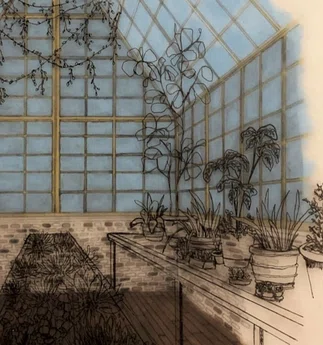




Anastasia Hauser
Hauser
William Amos Hough High School|Cornelius, NC
TEACHER: katherine Allen
Drawing

Green-House|17.5 x 12 in.
Idea(s): Green house design with intended effect of looking as if peering through a glass panel.
Material(s): Clear acrylic board, acrylic paint, finishing spray, and pen.
Process(es): Experimented with acrylic and reverse painting, drawn on the front and back of a clear material.

Green-House|Detail Image
Material(s): Clear acrylic board, acrylic paint, finishing spray, and pen.
Process(es): Experimented with acrylic and reverse painting, drawn on the front and back of a clear material.

For other AP Art students, I would recommend trying new techniques and ideas that may be out of your comfort zone because it creates growth.
Student statement
Student
statement
The piece related to the questions that guided me through my sustained investigation by making me question which materials could be utilized to create the most immersive experience for the viewer and how to create the mood of a piece best when thinking of rooms in homes.
For this piece, I utilized clear acrylic paneling, acrylic paint, and a pen. To create the visual effect of an observer looking into a greenhouse I drew the base with a pen on one side of the acrylic and then proceeded to apply paint on top of the existing pen. Following this, I applied the pen detailing of the plants and structures to create an overlay effect on the other side of acrylic paneling. For this piece, I had to experiment with applying materials onto the acrylic surface because the pen would smear therefore I was originally unable to apply detail and needed clear sealant spray.
Making art this year was different compared to previous years and I think teacher involvement was more crucial than ever. I say this due to all of the pieces being created at home so there wasn’t a creative environment you were surrounded by, other than the effort made by your teacher.
As a result, listening and thinking deeply about activities that were given, especially planning, was more significant than ever. I learned when I had a general idea of the piece I wanted to create, thought out, and sketched the final piece was more complex and interesting.
This was because I wasn’t starting from scratch which prompted more time to think creatively.
To develop original and creative ideas for the art projects I utilized Pinterest to see what materials other artists applied and common house designs and furniture. I also would try to find inspiration in the places I traveled. For other AP Art students, I would recommend trying new techniques and ideas that may be out of your comfort zone because it creates growth.
Anastasia Hauser
Teacher
statement
Katherine Allen
Ana came into my AP studio class with strong technical drawing skills. We focused on experimentation and the development of her own personal voice in her work. Pushing her out of her comfort zone but still retaining her delicate refined drawing style. I always encourage my students to break the rules and mix media in unconventional ways. Last year in 2-D design she began taking risks combining her controlled architectural line drawings with colorful loose blind contours of flowers. This year in Drawing she began incorporating unique physical surface materials like acrylic and ceramic tile, creating connections to the spaces she was illustrating through the materials themselves. For this piece, she experimented with different ways to get her drawings to adhere to the acrylic surface and how to use both sides to create depth.
I have students plan out the general compositions and loose ideas for each piece in the fall. It gives them a framework to approach their investigation and allows them to learn from each piece as they go and think about how they might alter their designs or incorporate new media in future pieces based on the outcome of their current work. They often make the pieces out of order depending on time and which idea they are most excited about at the moment. Sometimes they stick very close to the original plan and sometimes their idea evolves as they work. It gives them the freedom to change direction while still keeping the work unified.
Anastasia Hauser







